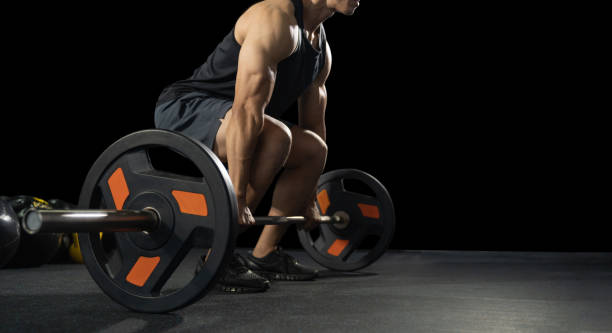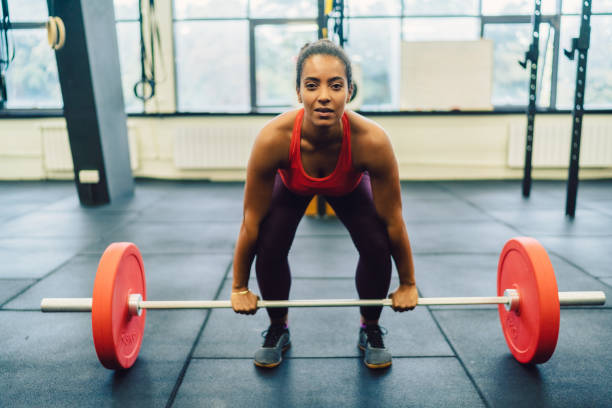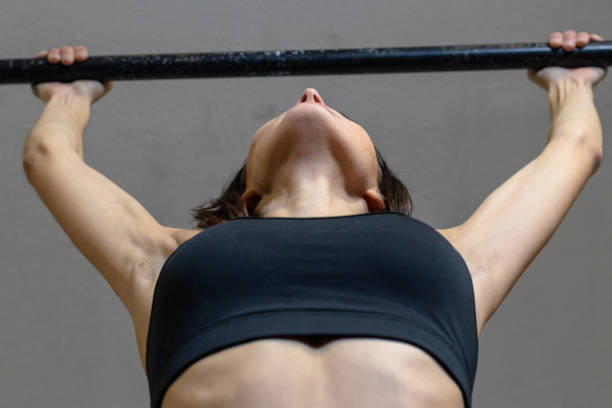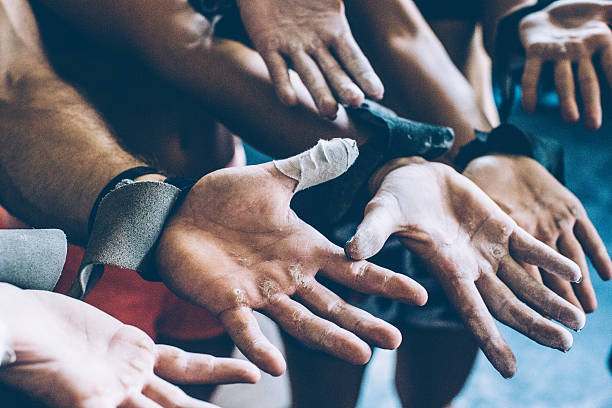
Introduction to Hook Grip Deadlift: The Technique and Its Advantages
Have you ever heard of the hook grip deadlift? It’s a powerful technique professional weightlifters and athletes use to improve their strength and reduce their risk of injury. Let’s take a closer look at what the hook grip deadlift is and why it’s important.
Definition of Hook Grip Deadlift
The hook grip deadlift is a type of deadlift where you hold the barbell with your fingers and thumb. Unlike a traditional deadlift grip, where you hold the barbell with your palm facing down, the hook grip allows your thumb to be wrapped around the barbell and sandwiched between your fingers and the barbell. This grip creates a stronger and more stable hold on the bar.

Importance of Grip in Deadlifting
Grip strength is essential in deadlifting. It isn’t easy to lift heavy weights without a strong grip, and your form can suffer. Proper grip also helps to keep the weight close to your body, which reduces the chances of injuring your back or other muscles.
Why Use the Hook Grip While Deadlifting: Top Reasons for Choosing This Technique
Now that we understand what the hook grip deadlift is, let’s look at why it’s a great choice of grip when deadlifting.
Enhanced Lifting Power and Stability
One of the significant advantages of the hook grip deadlift is that it enhances lifting power and stability. With your thumb securely gripping the bar, your fingers can apply more force to the barbell during a lift. This allows you to lift heavier weights with greater power and control.
Reduced Risk of Injury
Another essential advantage of the hook grip is that it can reduce your risk of injury. By holding the barbell closer to your body, the hook grip promotes proper body mechanics and posture during a lift. This reduces the risk of experiencing strain or injury to your back or other muscles.

Hook Grip Deadlift Benefits: How It Can Improve Your Performance
Now that we know why the hook grip deadlift is such a great technique, let’s look at how it can help improve your performance.
Increased Grip Strength
The most significant benefit of the hook grip deadlift is that it can increase your grip strength. You’re training your fingers and thumb to hold onto the bar with greater strength by repeatedly using the hook grip technique when deadlifting. This increased grip strength translates into better overall strength and performance in other physical activities.
Improved Posture and Body Mechanics
The hook grip also encourages better posture and body mechanics. By holding the bar closer to your body, your shoulders stay engaged, and your spine stays neutral during a lift. This decreases the stress on your lower back and core muscles while lifting heavy weights.

Improving Posture with Hook Grip Deadlifts
How Hook Grip Promotes Proper Body Alignment
Proper posture is crucial in any exercise, including deadlifts with the hook grip. To perform a hook grip, you wrap your fingers and thumb around the bar with your thumb, which creates a secure grip on the bar. This technique puts less strain on your wrists and fingers, allowing you to lift heavier weights with proper alignment.
Tips for Maintaining Good Posture During Deadlifts
To maintain good posture during hook grip deadlifts, you need to keep your shoulders back and down, chest up, and spine straight. Your hips should be lower than your shoulders, and your knees should be over your ankles. Engaging your core muscles and keeping your back flat throughout the lift is important to reduce the risk of injury.
When to Use Hook Grip Deadlifts: Identifying the Right Time and Situation
Appropriate Training Phases for Hook Grip Deadlifts
After mastering the conventional deadlift with proper form, you can gradually start incorporating the hook grip into your training regimen. Start with lighter weights to get used to the hook grip’s security alone, then increase the weight as you feel comfortable.
Factors to Consider Before Implementing Hook Grip
Before you implement the hook grip into your deadlift routine, consider your current level of strength and the goals you want to achieve. The hook grip is most beneficial for people who want to lift heavier weights without putting additional stress on their wrists and fingers. However, if you have wrist or finger injuries, you should avoid the hook grip until you have recovered.
Lifting Straps: An Alternative to Hook Grip Deadlifts
Benefits and Drawbacks of Lifting Straps
Lifting straps are an alternative to the hook grip that can provide additional support for your grip. However, they can also limit your range of motion and provide different benefits of forearm and grip strength than hook grip deadlifts.
When to Choose Lifting Straps Over Hook Grip
If you’re experiencing wrist or finger pain during deadlifts, lifting straps can help alleviate the pressure on your back by utilizing a hook grip. However, stick to the hook grip if you want to develop grip strength and improve forearm muscles.
Risks of the Deadlift Hook Grip: Understanding Potential Issues
One concern people have with the hook grip is that it can lead to hand injuries. However, using proper form and gradually increasing weights can minimize the risk of injury.
To mitigate the risks of the hook grip, listening to your body is essential. Stop and take a break if you feel pain or discomfort during deadlifts. Stretching your wrists and fingers before and after lifting is vital to promote flexibility and reduce stiffness.
Pros and Cons of the Hook Grip While Deadlifting: Making an Informed Decision
Before we dive into the hook grip deadlift technique, let’s first talk about the pros and cons of using this technique. This will help you make an informed decision on whether or not to incorporate it into your weightlifting routine.
Advantages of Hook Grip Deadlifting
1. Improved Grip Strength: One of the main advantages of the hook grip is that it greatly improves your grip strength. This is because the thumb is used to pin the bar against the fingers, increasing the force that can be applied to the bar.
2. Increased Comfort: The hook grip is generally more comfortable than the mixed grip style (which we will discuss later) since both hands are in the same position.
3. Reduced Risk of Bicep Tears: When using the mixed grip, the biceps can be at risk of tearing due to the uneven weight distribution on the arms. The hook grip reduces this risk since both hands are in the same position.
Disadvantages and Potential Issues
1. Painful: The hook grip can be painful, especially for beginners. This is because the thumb is pressed hard against the bar, which can cause discomfort or bruising.
2. Requires More Practice: The hook grip requires more practice to get used to compared to the mixed grip. Developing the strength and muscle memory required for the hook grip takes time.
3. Potential Lifting Limits: The hook grip may limit the amount of weight you can lift since it can be difficult to keep a grip on the bar when lifting heavier weights.
Mixed Grip Deadlifts: An Alternative to Hook Grip
The mixed grip is another technique to improve grip strength and lifting performance. In this technique, one hand is placed in standard overhand grip, and the other is underhand.
Benefits and Drawbacks of Mixed Grip
The mixed grip is easier to perform than the hook grip, especially for beginners. It also allows for a more secure grip on the bar compared to the traditional double overhand grip.
However, the mixed grip also has its drawbacks. One of the biggest drawbacks is that it can increase the risk of bicep tears. This is because the uneven distribution of weight on the arms can put a strain on the biceps.
When to Choose Mixed Grip Over Hook Grip
The mixed grip may be a better option if you start with deadlifts and are still deciding whether to get comfortable with the hook grip. It can also be helpful for those who have hit a plateau in their lifting performance and need to switch up their technique.
However, as you become more experienced and comfortable with the hook grip, switching to this technique may be better for long-term health and safety.
Hook Grip Deadlift Technique: Step-by-Step Instructions
Now let’s dive into how to perform the hook grip deadlift properly.
Proper Hand Placement and Thumb Position
1. Approach the bar with your feet shoulder-width apart and your toes pointing forward.
2. Bend down overhand position to grab the bar with a shoulder-width grip.
3. Place your thumbs on the bar first, with the fleshy part of your thumb between the bar and your fingers.
4. Your four fingers together should then curl around the bar, covering your thumbs.
5. The bar should sit on the middle finger and crease of your fingers and against the base of your palm.
Execution and Common Mistakes to Avoid
1. Lift the bar straight up, keeping your back straight and your head up.
2. Engage your glutes and hamstrings to complete the lift.
3. Common mistakes to avoid include rounding your back or lifting with your lower back instead of your legs.

Transitioning from Mixed Grip to Hook Grip Deadlifts
Tips for a Smooth Transition
If you are transitioning from a mixed grip deadlift to hook grip deadlifts, here are some tips to make the transition smoother:
1. Start with lighter weights to get comfortable with the new grip.
2. Use a wrist wrap to help keep your grip secure.
3. Practice the hook grip in other exercises, such as overhead presses, to help build strength and muscle memory.
Overcoming Challenges During the Switch
During the switch, it’s important to be patient with yourself and take things slow. Your grip strength needs to catch up to your lifting ability, and that’s okay.
In the meantime, work on your grip strength with exercises like farmer’s walks, pinch grips, and wrist curls. This will help you build the strength you need for the hook grip deadlift and other exercises that require grip strength.
Building Endurance with Hook Grip Deadlifts
If you want to build your endurance with hook grip deadlifts, there are a few things you should keep in mind.
Training Frequency and Progression
First, aim to do hook grip deadlifts at least once or twice weekly. This will help your muscles get used to the exercise and strengthen them over time.
To see progress, you should increase the weight you are lifting gradually. This means adding small increments to the weight every week or every other week. This will help your muscles to adapt to the increasing load and grow stronger over time.
Exercises to Improve Hook Grip Stamina
You can also do exercises specifically designed to improve your hook grip stamina. One such exercise is the farmer’s walk, which involves carrying heavy weights in each hand and walking around for a designated time or distance. This exercise targets the forearms and grip strength, enhancing your hook grip ability.

Addressing Pain and Discomfort During Hook Grip Deadlifts
It’s common to experience pain and discomfort during hook grip deadlifts, especially if you’re a beginner. Here’s how you can address these issues.
Identifying and Managing Common Sources of Pain
First, you should identify the source of the pain. Is it coming from your thumbs? Your fingers? Your wrists? Once you have identified the pain, you can take specific measures to manage it.
Tips for Reducing Discomfort and Preventing Injury
One of the best things you can do to reduce discomfort and prevent injury is to warm up before the workout. This includes stretching, lightweight exercises before heavy lifting, and taking breaks between sets.
Troubleshooting Common Hook Grip Deadlift Problems
If you’re experiencing difficulties with hook grip deadlifts, here are some ways to troubleshoot common problems.
Slipping Grip and How to Fix It
One common problem when doing hook grip deadlifts is a slipping grip. If this happens, you can use chalk to improve your grip. Applying chalk to your hands can help to absorb moisture and increase friction between your hands and the bar.
Thumb Pain and Strategies for Relief
If you’re experiencing thumb pain, try switching to mixed grip deadlifts or using straps to help you lift the weight. Mixed grip deadlifts involve holding the bar with one hand in a palms-down position and the other in a palms-up position. Straps wrap around the bar and your wrist, allowing you to hang on to the weight without worrying about your grip.
Hook Grip Deadlift Variations: Exploring Different Techniques
Finally, there are several variations of the hook grip deadlift that you can explore. Sumo Hook Grip Deadlift
The sumo hook grip deadlift involves taking a wider stance and holding the bar with a hook grip. This variation targets the inner thigh muscles and the hips.
Romanian Hook Grip Deadlift
The Romanian hook grip deadlift involves bending your knees slightly and then hinging your hips backwards while holding the bar with a hook grip. This variation targets the hamstrings, glutes, and lower back muscles.
In conclusion, hook grip deadlifts are excellent for building strength and endurance. By following the tips and techniques outlined above, you can improve your grip strength, reduce discomfort and pain during heavy lifts, and explore deadlift variations targeting different muscles. Keep on lifting!


Leave a Reply